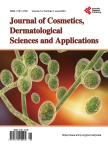The Frequency of Nail Changes and Disorders in Iraqi People above 50 Years Old
The Frequency of Nail Changes and Disorders in Iraqi People above 50 Years Old作者机构:Head of Dermatology Department College of Medicine University of Kufa Kufa Iraq Ministry of Health Baghdad Iraq
出 版 物:《Journal of Cosmetics, Dermatological Sciences and Applications》 (化妆品、皮肤病及应用期刊(英文))
年 卷 期:2016年第6卷第4期
页 面:124-132页
学科分类:0202[经济学-应用经济学] 02[经济学] 020205[经济学-产业经济学]
摘 要:Background: Nail changes associated with ageing are common in the elderly and include characteristic modifications of color, contour, growth, surface, thickness and histology. No cutaneous examination is complete without a careful clinical evaluation of the nails. Objective: The aim of present work is to assess the frequency of senile nail changes and disorders in Iraqi people above 50 years old compared with control age group (20 - 30 years old). Patients and methods: This case-controlled, cross-sectional study was performed in the outpatient clinic of Dermatology and Venereology Department at the Kufa College of Medicine Teaching Hospital in Najaf Province in the period from September 2010 to April 2011. The study included 200 subjects, of which 100 patients were above 50 years old (study group), and the other 100 subjects were from 20 - 30 years old (control group). A detailed history from each subject was recorded to detect the onset, duration and progression of nail changes and/or disorders, their occupation and any environmental exposure. A careful examination of the nails was carried out to assess the type of nail changes, site and symmetry. Any patient with systemic disease, dermatological disease or with suspected drug intake was excluded from the study. Results: The present work has shown that many nail changes were more frequent among older age individuals than younger age group with significant statistical difference (p = 0.043 - 0.000) like dull opaque appearance, rough lusterlessness, longitudinal ridging, altered thickness, ragged cuticle, altered contour, subungual hyperkeratosis and scaling nail folds. Chromonychia was not statistically significant (14% of study group versus 16% of the control) with p = 0.692. Longitudinal melanonychia was significantly higher in the study group (6% versus 0% of the control) with p = 0.013, while punctate leukonychia was significantly higher in the control group (16% versus 4% of study group) with p = 0.005. Conclus



